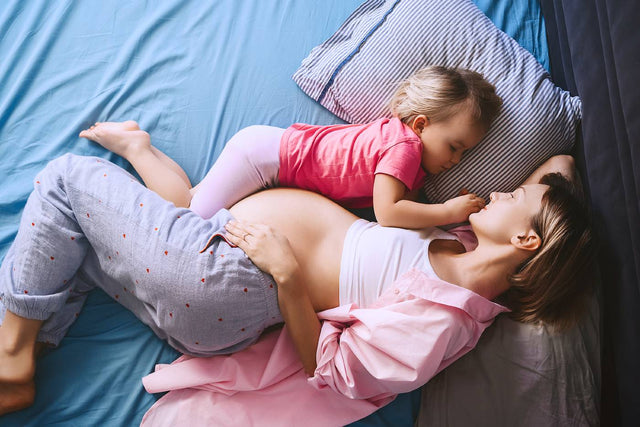Yes! White Noise Helps the Whole Family Sleep

On This Page
Right now, your biggest sleep concerns likely revolve around your baby or toddler…which makes sense. When Baby sleeps, everyone sleeps! But what if you started treating your own bedtime and sleep space with the same care and concern you bestow upon your children?
My guess: You’d start sleeping better! While there are no adult Sleepeas or SNOOs , there is one baby-sleep essential that’s perfect for the whole family…and that’s white noise. Here’s how to use white noise to help everyone get the rest they need:
How White Noise Helps Infants Sleep
When your baby was in the womb, they were serenaded by a constant flow of rumbly sounds. These sounds kept your baby happy and calm…and that’s exactly why your little one wants more of the same once post-womb! The familiar, low, rumbly, and gentle, shower-like sound of white noise helps turn on your baby’s innate calming reflex, or their built-in “on switch” for sleep. And when that white noise is slightly rougher—and as loud as your baby’s crying—it works to quiet cries and fussiness, too. You can easily make your own baby-soothing white noise by making a strong “Shhhhhhhhhhhhhhh” sound right into Baby’s ear. Of course, shushing at your baby all night long would be pretty exhausting! And that’s why relying on a quality white noise machine, like SNOObie or SNOObear, is the easier route.
Research Shows White Noise Works!
While fellow parents (and pediatricians like me) can sing the praises of white noise till the sun comes up, it’s always a great sign when science backs up what we already know to be true: White noise helps babies sleep! For instance, a study published in the peer-reviewed journal Archives of Disease in Childhood, found that white noise helped 80% of infants fall asleep in just 5 minutes. Another study in the Journal of Clinical Nursing found that white noise was particularly helpful with colicky babies, significantly decreasing their crying and increasing their sleep. The research doesn’t stop at babies. When white noise is used in noisy hospitals, it can help reduce the time it takes for adult patients to fall asleep by about 40%, according to a report in Frontiers in Neurology.
White Noise Continues to Work for Older Babies
At around 3 to 4 months old, your baby’s natural calming reflex fades…but don’t worry! Once you start using white noise in the background during your baby’s bedtime routine, they’ll start to expect it and make the connection that white noise means sleepytime is here. That means every time you turn on white noise, your sweet pea will think, “Hey, I know that sound! It must mean it’s time to sleep.” (It’s like magic!) Meanwhile, white noise helps to distract children from some common internal sleep-sappers, such as teething pain, a slightly stuffy nose, or mild hunger. (By the way, white noise will never keep a truly hungry baby sleeping!) To put it simply, white noise gives your wee nugget something else to pay attention to, which can then help lull them to dreamland.
Why White Noise Works for Big Kids and Grownups, Too
Do you still get drowsy when riding shotgun? Does the gentle jostling of a car ride coupled with the steady hum of the highway bring on the yawns? If so, you already know that the power rocking and white noise can last and last! Beyond the muscle memory that spurs road trip sleepiness, white noise also works like magic to muffle jarring sounds, like a blaring television in the next room or a loud truck passing by, that could easily wake you up. Proper white noise creates a blanket of sound that masks sudden shifts in sound consistency that can often wake people up. The key: Picking the right white noise, which is low-pitch, droning, and hypnotic—not inconsistent, like music, ocean waves, or chirping birdies.
White Noise During Pregnancy
As your baby bump grows, and pregnancy hormones course through your ever-changing body, you’ll begin to experience less slow-wave sleep (aka deep sleep). Sadly, that means you become more prone to middle-of-the-night wakeups. The good news: Using a white noise can help off-set this new sleep hiccup. In fact, a 2017 report in the journal Sleep found that white noise improves sleep quality—and helps those with sleep issues fall into deep sleep more quickly. Hurrah! (Learn more about getting the ZZZs you need while expecting.)
White Noise Dependency and Sleep
Fantastic news: There’s absolutely no need to turn off your nighttime (and naptime) white noise! You can continue playing white noise for your children and yourself for, well, ever, to help boost sleep. Think of white noise as just another healthy sleep tool, along with your comfy pillow and cozy blanket, that helps get you and your family to dreamland. (Speaking of pillows and blankets, those are no-nos for children under a year old!) Of course, if you’d like to wean yourself or your child off white noise, it’s actually pretty easy. Just gradually lower the sound, bit by bit, over a week or two until it’s finally off.